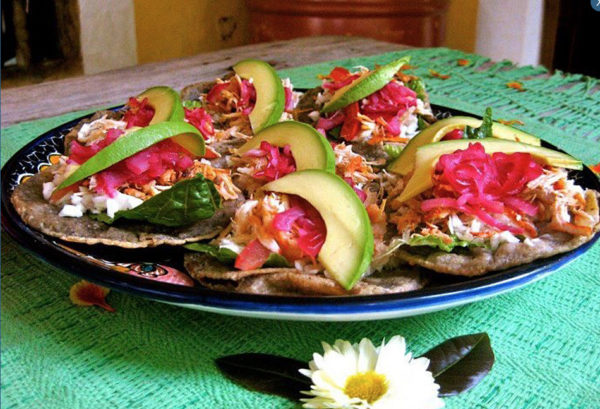According to Travel Market Report, Mexico’s Yucatan State is a magical place to spend a vacation … as long as you know where to find it!
It’s often confused with the Yucatan peninsula as a whole, which includes the states of Quintana Roo (Cancun, Cozumel, Isla Mujeres, Playa del Carmen, Xcaret, etc.) and Campeche (the walled city of Campeche and the jungle city of Calakmul, etc.). And when travelers correctly place Chichen Itza as part of Yucatan State, many believe that the complex of Mayan ruins is the only reason to visit the Yucatan. Simply spoken, they are wrong!
On a recent trip to the Yucatan, we explored many of the sites, tasted the delicious food, sampled refreshing beverages, and enjoyed great conversations with Yucatecos (the people of the Yucatan). But throughout our journey, we had questions in mind about Mexico tourism’s “new direction,” where some $300 million was to be re-allocated — from the promotional tourism boards across the country, to the Mayan Train that would connect the towns and cities of the Yucatan peninsula.

Panuchos
Photo: Google
The cuisine
So, who better to ask than Miguel Andres Hernandez, the Vice Minister of Tourism for the State of the Yucatan? The very congenial Vice Minister joined us for dinner at Parque de Santa Lucia in Merida. We started off with something of interest to all travelers: food. As we munched on delicious appetizers of corn empanadas with black mole, and octopus ceviche with scallops, Miguel spoke about the 1,500 different types of Tequila now on the market (and the host of recently hired Yucatan mixologists to help visitors appreciate the beverage).
He noted the growth of gastronomy in the area, not only with 15 new chefs in Merida alone, but also in the appreciation of classical cuisine. A “pib” is the Mayan word for an underground oven. And we were told that 50%-60% of Mayan food is cooked underground. In some towns, Valladolid for example, 73% of the people are of Maya-Mixtes heritage, and therefore in the Yucatan, the norm is to find that gastronomic expectations have been greatly exceeded.

Maya Train (Photo: vanguardia.com.mx)
The Maya Train
Miguel went on to talk about the Maya Train, which he described as a great concept “if, in fact, it’s built.” (As a matter of note, Enrique Peña Nieto, the past President of Mexico, canceled plans in 2012 to build a Cancun-to-Merida train due to austerity cuts). The benefits of the project would have far-reaching effects. It would protect historic sites and the environment; promote tourism, education and entrepreneurialism; and would go the distance in taking a sustainable approach to the culture of the Yucatan.
Miguel noted that “thirty percent of the people who come to Mexico on a cruise ship, return,” so first impressions are very important. And the Vice Minister asserted that tourism partnerships were also important. The success of other areas, notably Puerto Vallarta and Riviera Nayarit, were constantly being reviewed in the context of adopting best practices to the Yucatan.
Miguel mentioned that the Mayan Train stations had not yet been determined, but that Puerto Progresso (the port city on the Yucatan Peninsula) would definitely need to be included, as would Merida (the capital of the state) and the Magical Towns of Valladolid and Izamal. (Magical Towns are designated by a committee where the “magical experience” takes into consideration specific criteria, such as natural beauty, cultural richness, traditions, crafts, food, festivals, exceptional hospitality, and more).

(PHOTO: amadeus.com)
Reasons to go
Miguel reminded us that Tianguis Turistico, the annual tourism fair, would be held in Merida in 2020 to showcase not only the city, but the treasures of the Yucatan. And when asked why travelers should consider a holiday in the state, he noted the following:
- The Yucatan is safe for tourists. It has been rated one of the safest places in Mexico for the last 12 years. “We don’t even have aggressive merchants,” Miguel said.
- Accommodations are plentiful. Merida has 7,300 hotel rooms, out of the 13,000 available in the state; and Yucatan tourism is currently working with Airbnb.
- The Yucatecos enjoy telling their stories. “Talk to the locals, and hear real history from the source,” Miguel noted.
- Out of the 6,000 cenotes in the country (a cenote is a surface pool, connected to a subterranean water source), the Yucatan boasts 3,000 cenotes that are open to the public, “and every one is different.”
- The Yucatan has great diversity: beaches, forests, nature reserves, and 19 archeological sites that are open to the public.
The Vice Minister of Tourism also reminded us that “we have great weather”; and that while prices tend to be higher in neighboring states, “the quality of the experience is higher in the Yucatan.”
Source: Travel Market Report

